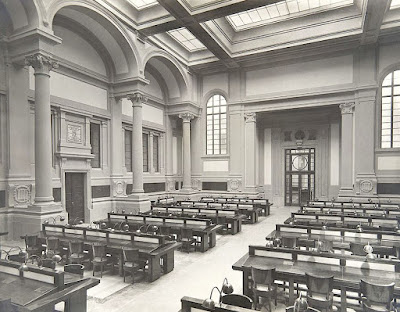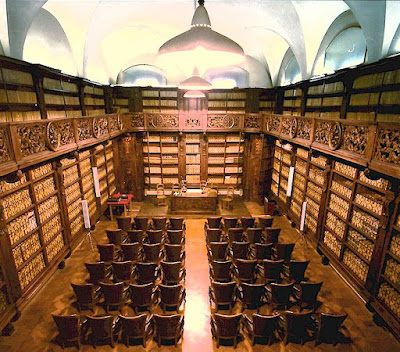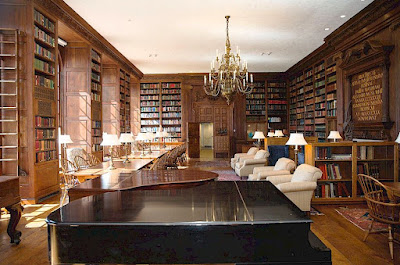The
historical libraries of Florence preserve some of the most important book, periodical and manuscript collections in Europe. One or two of them are in themselves works of art, ranking among the most beautiful in the world.
The most beautiful libraries of Florence
La Biblioteca Nazionale Centrale di Firenze
 |
| Reading room of the Biblioteca Nazionale Centrale di Firenze
|
Let's begin with the
Biblioteca Nazionale Centrale di Firenze because it is the largest library in Italy, housing as it does more than six million volumes. The library was founded in 1714 and opened to the public under the name
Biblioteca Magliabechiana in 1774 which of course long predates the formation of the modern country of Italy. That's why this national library is located in Florence. There is also a large National Library in Rome, founded in 1876, and a much smaller one in Naples, the splendid
Biblioteca nazionale Vittorio Emanuele III.
Since 1935, the collections of the BNCF have been housed in a neo-classical structure designed by Bazzani and Mazzei, and located near the Arno in the Santa Croce district. Tragically, as a consequence of its location, the 1966 flood damaged nearly one third of the library's holdings, most notably its periodicals, and the Palatine and Magliabechi collections, and some were irrecoverably lost.
The reading room is severely neoclassical, making it, for me, the least attractive of Florence's important libraries.
La Biblioteca degli Uffizi
 |
| The reading room of the Biblioteca degli Uffizi in Florence
|
The
Uffizi Library, much frequented by art historians but much less known to the general public, was founded in the second half of the 18 C by the
Grand Duke Peter Leopold and over the years has specialised in the field of art history. The Uffizi Library was housed up until 1998 in the part of Vasari’s complex that was originally the
ridotto or foyer of the Medici Theatre. The new location was opened on 16 December 1998 in the renovated areas previously occupied by the Biblioteca Magliabechiana, under the porch, near the entrance to the gallery. It's not a large library, but has very good holdings of periodicals. The 78,600 titles include 470 manuscripts, 5 incunabula, 192 sixteenth-century books, 1,445 books printed between 1601 and 1800 and 1,136 periodicals. The reading room is quite spectacular, as we would expect in a part of the Uffizi.
La Biblioteca Marucelliana
 |
| The reading room of the Biblioteca Marucelliana in Florence |
The Marucelliana Library is the result of a bequest by Abbot Francesco Marucelli, from whom the library takes its name. The donation of this rich and substantial library was made with the express aim of facilitating study by young people from the poorer sector of the Florentine populace. It was opened to the public in 1752. The structure was built specifically to house the library. Construction (1747–1751) on Via Cavour was directed by the architect Dori who had won the public contest for the design. By the late 18 C, space was becoming tight, so that the library had to be expanded beyond the original building into the adjacent Palazzi Della Stufa and Pegna, and the ground floor of the Palazzo Fenzi Dardinelli. Although not great architecture, the Marucelliana Library has a wonderfully homely feeling about it - a bibliophile's paradise!
La Biblioteca Riccardiana
 |
| The reading room of the Biblioteca Riccardiana in Florence |
The
Riccardian Library was founded in 1600 by Riccardo Riccardi and was moved to its present location in 1670. In 1715, it was opened to the public. In 1812, there was a risk of the library being auctioned off, but the Florence authorities were authorised by the Government to buy it, which they did in 1813 and two years later it was sold to the state. I'm a sucker for Baroque libraries, and so you can readily imagine, I come and spend a bit of time in the Biblioteca Riccardiana whenever I need a bit of aesthetic relaxation. The library is packed with treasures. For example, it holds a copy of Pliny's
Historia naturalis dating from the 10 C and an autograph manuscript of the
Florentine Histories of Niccolò Machiavelli.
La Biblioteca Moreniana
 |
| The Biblioteca Moreniana in Florence |
In the same building as the Riccardian Library, the Palazzo Medici Riccardi, we have
Morenian Library which speciliases in the history and culture of Tuscany. The library originated with the acquisition in 1870 by the Florentine authorities of the library assembled by Pietro Bigazzi. The most important foundations of the collection were parts of the library of Domenico Maria Manni and that of Domenico Moreni, compiler of the annotated historical bibliography of Tuscany (1805), and consisting mostly of documents relating to the history and culture of Tuscany. Subsequent acquisitions included collections formed by other scholars and gatherers Tuscan antiquities such as enthusiasts like Giuseppe Palagi, Emilio Frullani and Giovanni Antonio Pecci. In 1942, the library was opened to the public in the historical setting of the Palazzo Medici Riccardi next to the Biblioteca Riccardiana. In recent decades, other manuscripts of particular interest for the history of Tuscany have become part of the library's patrimony including of books by Rubieri-Zannetti, Rosini and Ombrosi Frullani). Since 1978, the library has been managed directly by the Province of Florence while continuing to share some public services with the Biblioteca Riccardiana.
Biblioteca dell'Accademia di Belle Arti di Firenze
 |
| Biblioteca dell'Accademia di Belle Arti di Firenze
|
The
Library of the Academy of Fine Arts is located on via Ricasoli, next
door to the
Galleria dell'Accademia where the original statue of David
is displayed. The library first saw the light of day in 1801 with the purchase,
sponsored by Giovanni Degli Alessandri, the then president of the
Accademia di Belle Arti di Firenze and director of the Uffizi, of the
library belonging to the architect Giuseppe Salvetti. The library
contains texts relating to the history of art and music. The reading
room is quite small with a pleasing ambience with a number of fine
sculptures decorating the space.
La Biblioteca Medicea Laurenziana
 |
| La Biblioteca Medicea Laurenziana in Florence |
The
Laurentian Library is one of the major collections of manuscripts in the world and a major architectural gems of Florence. The library was designed by Michelangelo between 1519 and 1534, but work was completed only in 1571. Laurentian Library was built in a cloister of the Medicean Basilica di San Lorenzo di Firenze under the patronage of the Medici pope, Clement VII, to emphasize that the Medici family were no longer mere merchants but members of "the better classes". To me, this library is one of the most perfect, in architectural terms, in the world. Even leaving that aside, the library contains the manuscripts and books belonging to the private library of the Medici family, the collection now amounting to about 11,000 manuscripts, 2,500 papyri, 43 ostraca, 566 incunabula, 1,681 16 C prints, and 126,527 prints of the 17 C to 20C. Changing exhibitions allow one to view and study these incredible treasures.
More about the Laurentian Library.
Il Gabinetto Scientifico Letterario G. P. Vieusseux
 |
| Conference room of the Vieusseux Library in Florence |
The
Vieusseux Library in Piazza Strozzi was founded in 1819 in Florence by Giovan Pietro Vieusseux, a Genovese banker, merchant and publisher. The reading room made leading European periodicals available to Florentines and visitors from abroad in a setting that encouraged conversation and the exchange of ideas so that the library soon became a cosmopolitan meeting point of Italian and European culture. A circulating library with the latest publications in Italian, French and English was later installed next to the reading room. Numerous literary Italians, among them Giacomo Leopardi and Alessandro Manzoni, frequented the Gabinetto Vieusseux when they were in Florence, as did literary foreign residents and visitors, including Stendhal, Schopenhauer, James Fenimore Cooper, Thackeray, Dostoevsky, Mark Twain, Émile Zola, André Gide, Kipling, Aldous Huxley and D. H. Lawrence. The warm 19 C conference room is the part of the library most familiar to the public.
The Berenson Library at Villa I Tatti
 |
Berenson Library at Villa I Tatti
|
The most recent foundation in our list is the Berenson Library which is a part of
Villa I Tatti, the home of the art historian Bernard Berenson for most of his life and now an Italian Renaissance research institute belonging to Harvard University. Villa I Tatti located outside Florence close to the municipal boundary with
Fiesole and near
Settignano. Bernard Berenson lived there from 1900 and the adjoining library and art collection were designed for him in 1936. Berenson was a fastidious man in himself (personally - although it tormented him, his relationship with the art dealer Duveen and others was not quite so fastidious) and not surprisingly his library is exquisite. He accumulated (and often read) a huge number of art historical books and periodicals, and these form the basis of this, one of the most beautiful and complete small libraries created during the 20 C.
Historical villas of Tuscany.
Historical gardens of Tuscany.
 |
Don't forget to visit my Tuscany
Travel Guide!
Up-to-date news on what to see and where to stay in Chianti and all of Tuscany.
Tuscany Travel Guide
|
|
Author: Anna Maria Baldini










